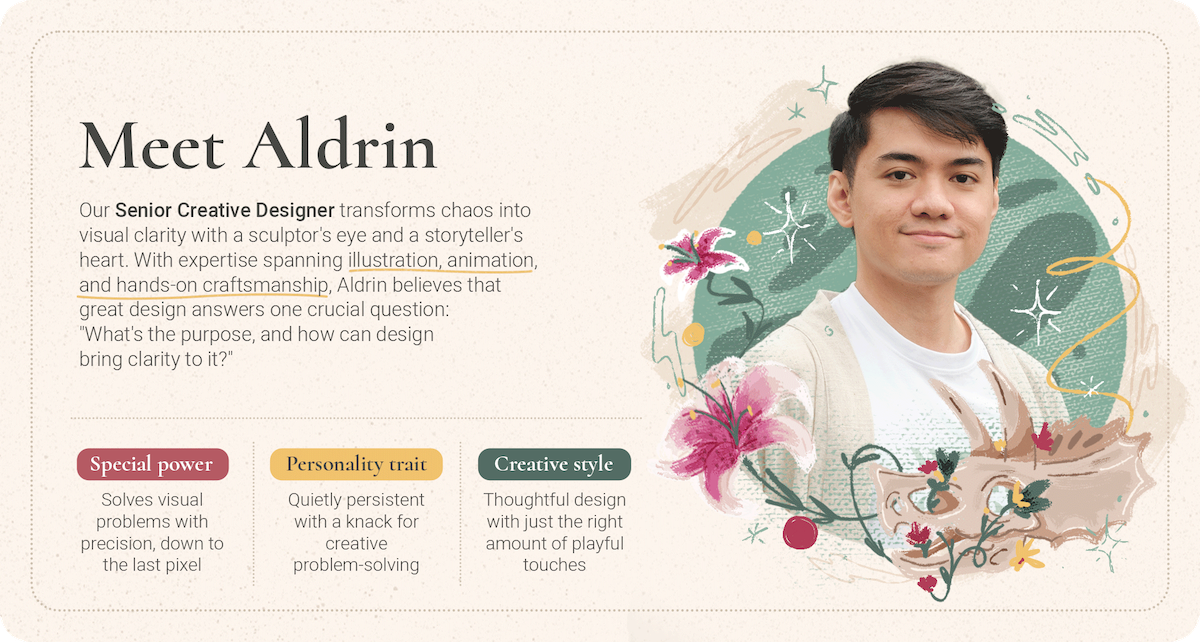
Case studies are useful tools in a B2B company’s sales arsenal.
These documents show potential customers that other companies have faced similar problems, and are now in a better place because they have overcome their struggles (with your help, of course).
But the thought of case studies might bring to mind a formal document that describes in stiff language how a product solved a problem. Many business case studies are admittedly boring, and not very helpful.
So it’s refreshing to hear what Evan Tan, Chief of Staff at data analytics and business intelligence startup Holistics, has to say about this type of content.

To Evan, case studies are a form of storytelling about their customers’ struggles and successes. “Focusing on the human element of the story is very important,” he says.
Painting this concrete picture is especially helpful for products that many companies have not used before—such as an end-to-end data analytics and business intelligence platform like Holistics.
Such a platform can have vast applications across different industries, but the target market might not even be aware that it exists, or that it can solve the challenges they’re facing.
That’s why case studies “are highly effective in taking your selling to the next level,” says Evan.
By that, he means the art of story-based selling.
Case studies are story-based sales tools
To understand story-based selling, Evan points us to Andy Raskin, a pitching coach famous for his article, “The Greatest Sales Deck I’ve Ever Seen” (it has 92,000 claps on Medium as of this writing).

In his post, Andy outlines the elements of a strategic narrative for sales pitches.
First, describe how the audience’s world has changed “in such a way that presents both great opportunity and great risk.”
Next, describe the Promised Land—the improvements and successes the audience will experience with your help.
Only after painting these pictures do you talk about your product or service. You’ll also need to provide evidence that you can deliver what you’re promising.
That’s where case studies come in.
Case studies are “in-depth investigations of a single person, group, event or community.” They typically involve interviews and, where possible, direct observation.
As a content marketing and sales tool, a case study tells the story of how some companies have attained the Promised Land, and describes the journey they took to get there (hint: it involves your product or service).

Why do these stories work for sales?
They work because “people relate very well to stories,” says Evan.
Potential clients can see themselves in the narratives told by the case studies. If they can relate to the problems and aspire to the vision of success discussed in the case study, then chances are the proposed solution will resonate with them, too.
And by framing the narrative around the customer’s vision of success, companies can cut through the noise of other sales pitches that focus on the seller.
Craig Davis, a content strategist at Facebook and writer at Contently, even claims that “a good case study is arguably the most important piece of content you can create.”
“It arms sales teams with creative ammunition and provides proof for what you can do without the need for a hard sell,” writes Davis.
How to craft an effective case study
By now, it should be clear what makes a good case study—a clear and relatable narrative that depicts the subject’s pain and success, and how you helped them in their journey to the Promised Land.
In 2019, we worked with Holistics to create a series of case studies. Here are the steps we took.
1. Identify a client to feature based on certain criteria
As a B2B company, you’ll want to identify your existing clients who have interesting, unexpected, or niche use cases of your product or service. Be creative in using different channels to find these clients.
For Holistics, problems that clients described in their support tickets revealed the various ways they were using their business intelligence platform. Customer success calls were also another good source of information.
You can also identify verticals that you’re targeting and select clients operating in these spaces.
Or you might want to extend goodwill and gratitude to some of your oldest and most loyal clients by featuring them in a case study.
These are all legitimate criteria for choosing a client to feature in your case study.
2. Get multiple perspectives
Unless only one person in the client’s company uses and benefits from your product—a highly unlikely case—aim to have at least three interviewees with different job positions.
That’s because different stakeholders in the company use your solution in different ways. Each of them will have their own goals, challenges, successes, and tips to share.
For example, we featured Kata.ai to understand how they used Holistics to improve their chatbot product. While their Data Analyst talked about how they used Holistics to analyze conversational data, their Product Growth Lead shared that they also used the platform for tracking and measuring their own marketing campaigns.

By talking to people from different teams, we discovered the various ways they used Holistics within Kata.ai.
At times, the client you’re featuring might not be willing or comfortable to provide multiple interviewees. Try to dig deeper to learn why. If the reason is that there really is just a single user of the product, find out which departments benefit from that person’s work, and see if you can talk to people from those teams.
But if the client still says no—perhaps due to a lack of time—don’t push it.
Perhaps you can postpone the case study, as they might be more ready to share their stories and results a few months later. Or if they can only provide one interviewee, make sure you get sufficient information and ask questions about how other teams are using or benefiting from the product.
Another thing you can do is to support the case study with data from official sources from within the organization being featured, and even from third-party sources. If you’re analyzing an event instead of a person or organisation, this step is crucial.
For instance, we investigated how Klook’s travel blog ranked for 80,000+ keywords for a case study on With Content’s own blog. We interviewed their Marketing Manager (Content) SEA and supplemented this with data from Ahrefs, an online SEO tool that lets you audit websites.

An excerpt from our case study on Klook’s travel blog.
3. Decide how you want to structure the case study: Pain, Dream, Fix
Even before you conduct the interviews, you should already have a rough structure in mind. This will help you craft your interview questions because it will reveal the types of information you need to get.
For instance, Holistics uses a “Pain, Dream, Fix” approach to structure its case study narratives.
“Pain, Dream, Fix” is a copywriting model that is almost parallel to Andy Raskin’s strategic narrative framework. It gets the audience to see themselves in an advertisement and promises that their pain can be fixed and their dream fulfilled with the help of the advertised product.
Here’s how Holistics did it:
- Provide context. Talk about the featured company’s background and industry, the pain points they’re trying to solve for their customers, and their data sources.
- Paint the before-and-after scenario. This is where the “Pain” and “Dream” parts come in. How did they try to solve the problem before they began using Holistics, and what alternatives did they consider? How did they implement Holistics as a solution, and how did this change the way they work?
- Understand how your solution helped. What benefits did the company get from adopting Holistics? How important is it now in their daily work? If they would describe or recommend Holistics to other companies, what would they say?
- Look towards the future. Where does the company want to go, now that it has solved its problems? What does the future of data in their company look like?
4. Share interview questions in advance
Many of us aren’t as articulate and spontaneous as we’d like to be. For some people, participating in a case study might be their first experience of being interviewed.
To help your interviewees prepare themselves, share interview questions in advance. This also allows the interviewees to obtain the necessary data or to gather feedback and stories from their teammates that they can share with you.
5. Be personal and human when conducting the interview

Evan cautions against simply going through a checklist of questions during an interview.
He explains that the prepared interview questions help provide a structure to the interview—they’re not a script you need to stick to. But if the interviewee mentions something interesting or confusing, don’t hesitate to ask them to share more or clarify.
Try to tease out the stories behind the answers. “Why” and “how” questions are particularly useful for doing so. You can also ask directly for examples and anecdotes.
If, for example, the client says that the product helps them generate sales reports, you could ask:
- Why is it important that the product generates sales reports?
- How does the product’s method of generating sales reports differ from your previous method?
- How does this benefit you?
- Can you share examples of sales reports the product generated, and how you used these reports?
“Don’t shy away from being personal […] I think an authentic voice makes all the difference,” says Evan.
For that reason, face-to-face interviews are ideal. But if it’s not possible or feasible to meet up physically, the next best thing would be to have a video call.
6. Get concrete, hard facts
Since a case study is about demonstrating and proving that you can solve a problem, get the interviewees to provide specific results.
For example, in a case study featuring peer-to-peer marketplace Airfrov, an interviewee shared the following:
- “Before, if I wanted to make a promotion, I’d need three hours to see the data. [With] Holistics, I need [less than] 10 minutes to see and extract data.”
- “Around 90% of marketers in the company now use data regularly to make marketing decisions.”

When you pair this hard evidence with the concrete examples and anecdotes you get during the interview, you make a stronger case for why your product is the solution. You’re able to share both quantitative and qualitative facts that support your proposed “Fix” that bridges the “Pain” and the “Dream”.
7. Put a face to the name
If they’re willing, ask the interviewees to provide their pictures. By showing photos of users of their product, Holistics humanizes the case studies.
The appearance of a friendly face makes the featured client more relatable. It drives home the point that it’s not an abstract entity that’s using the product, but rather, real people with real problems.
8. Share, share, share
What use is a piece of content if no one reads it?
Don’t just let your case study sit on your website, gathering virtual cobwebs. Share it on social media and tag the client you featured. You can even distribute it through your newsletter, if you have one.
And of course, share it with your sales team so they can give copies to potential clients.
Bonus round: the unexpected benefits of case studies
After publishing a series of case studies last year, Holistics found that the benefits of publishing case studies went beyond having a story for salespeople to tell.
The case studies allowed them to improve their understanding of the ways customers were using the Holistics platform, as well as the struggles and triumphs that users had. A few times, a case study interview revealed ways the Holistics team could help improve the users’ workflow on the platform, resulting in a follow-up demo call.
At times, the interviews also helped the Holistics team discover potential gaps in their marketing communications and improve the way they shared information about new features.
“There’s really no replacing these deep-dive conversations,” shares Evan. Without doing the case studies, some of these gaps may not have surfaced. Even on a customer success call, you’d usually talk only to the main user of the product, not the various stakeholders.

In fact, the various customer use cases unearthed through their case studies were instrumental in writing an analytics guidebook. One of the praises for the book was about how it provided real-world case studies.
Go and unearth those stories
“Case studies have proven to be a very effective tool in our arsenal because they’re able to communicate the value and results that can be produced,” says Evan.
So find a place for case studies in your content marketing strategy. Work with your customer service and sales teams to identify existing clients you can feature, and unearth the stories that will help you sell your product in a compelling, relatable, and human way.
Or let us help you unearth, craft, and publish customer stories that will win you even more customers – just like we did with Holistics.
—
200+ industry-leading tech companies in Southeast Asia are happy clients of With Content. Join them and start delivering valuable content to your potential customers today.





